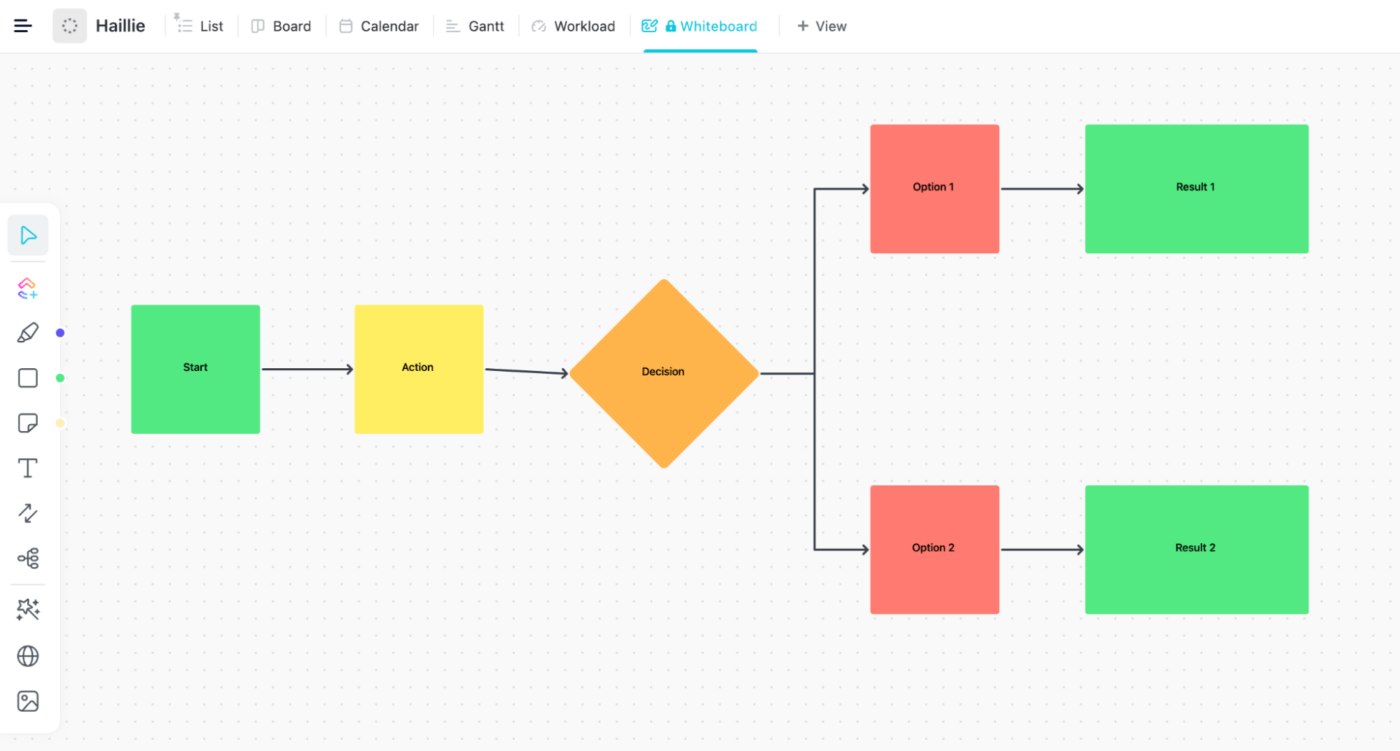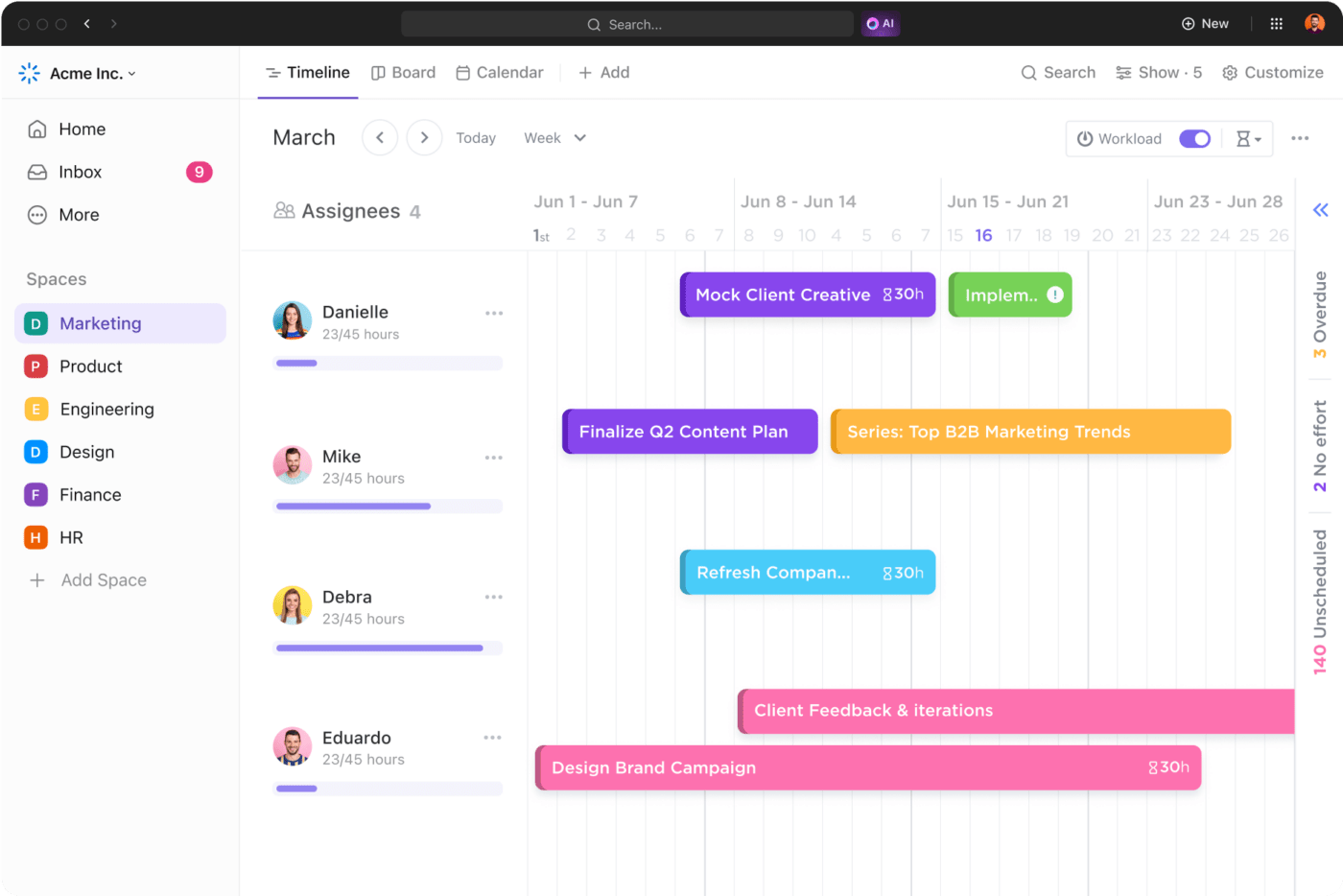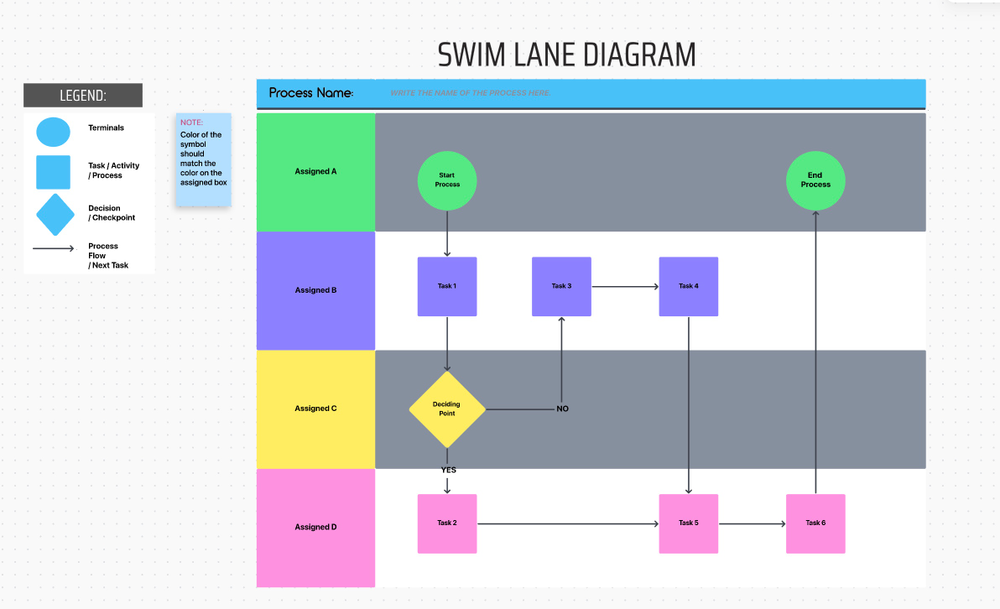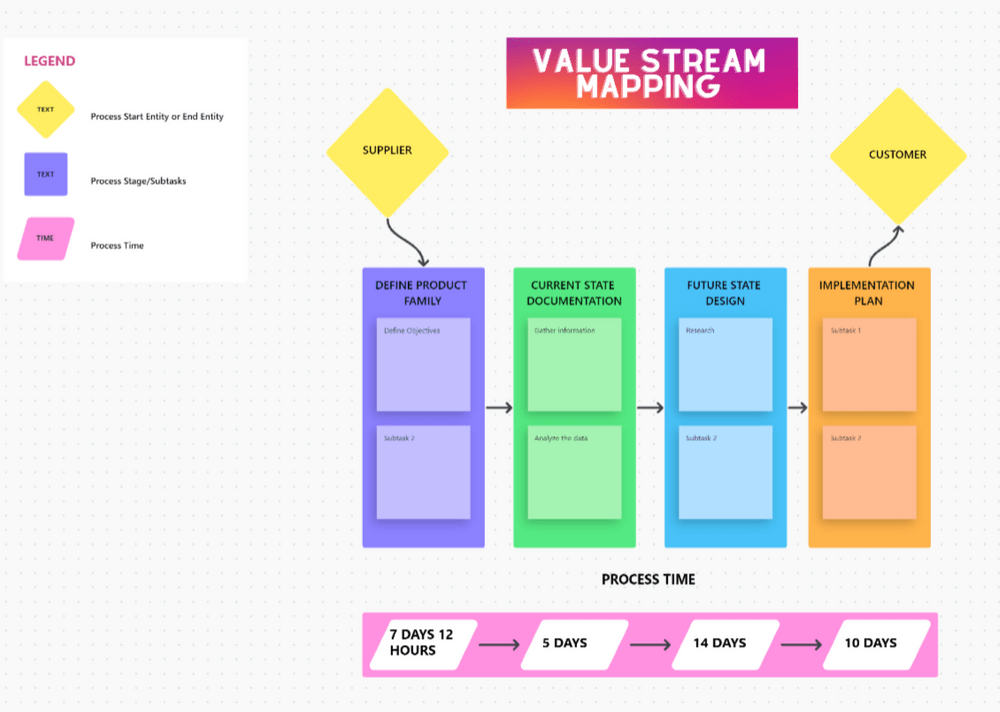أنت تحاول أن تصبح فريقاً أكثر كفاءة، فما الذي تحتاج إلى القيام به لتحسين أدائك؟
قد يكون تخطيط العمليات هو الأداة التي لا تعرف بعد أنك بحاجة إليها.
خريطة العمليات تجعل ما يحدث داخل الشركة مرئيًا - سواء كان ذلك في العمليات، أو كيفية إدارة المشاريع، أو كيفية أنظمة المشتريات أو حتى كيفية التعامل مع تذاكر دعم العملاء الواردة.
إنها طريقة مؤكدة لتحديد أوجه القصور، والثغرات في عمليات التفكير لديك، والاختناقات التي يمكن إصلاحها. ولكن إنشاء خريطة عملية تساعدك على التحسين يتطلب منك أن تكون على دراية بكل ما يتعلق برسم خرائط العمليات.
بمجرد أن تتعرف على رموز الخرائط وأفضل الممارسات، سترى مدى سهولة إنشاء خرائط عمليات سهلة من الصفر (أو استخدام قالب مُعد مسبقًا يمكن أن يساعدك حقًا أيضًا!) اربط حزام الأمان وتعمق في عالم رسم خرائط العمليات أدناه.

ما هو تخطيط العمليات؟
رسم خرائط العمليات هو تمثيل مرئي لعملية ما يساعد على تحديد أهم مكوناتها وأوجه القصور المحتملة. وهو يوفر نظرة عامة على العملية، ويحدد تسلسل الأحداث والمهام والخطوات المتضمنة في تحقيق نتيجة معينة.
تستخدم الشركات هذا النهج من أجل تحديد الاختناقات في سير العمل لديهم وتحسين نتائجهم في نهاية المطاف. يجب أن تعمل خرائط العمليات بشكل أساسي كمخطط تفصيلي لكيفية إنجاز فريقك للمشاريع عبر خط النهاية.
6 أمثلة على خرائط العمليات
يمكن استخدام خرائط العمليات بطرق متنوعة. كل هذا يعتمد على أهداف الفريق والهيكل الحالي لعملياتك التجارية. ولكن بالنسبة للجزء الأكبر، هناك ستة أنواع شائعة من خرائط العمليات. دعنا نلقي نظرة على كل منها وكيفية عملها.
1. مخططات انسيابية 
حقق أقصى استفادة من مهام سير عملك باستخدام اللوحات البيضاء باستخدام قالب المخطط الانسيابي في تطبيق ClickUp
في خريطة العملية القياسية هذه، تمثل الأشكال والرموز المهام والأحداث المختلفة. يعتمد تخطيط العمليات من البداية إلى النهاية عادةً على المخططات الانسيابية.
عندما تقوم بتخطيط العملية بأكملها، فإن المخططات الانسيابية هي أدوات مرئية مفيدة لتمثيل سلسلة من الخطوات. من بين الأنواع المختلفة من خرائط العمليات، يوضح هذا النوع من الخرائط الإجراءات أو الأنظمة المعقدة ويسهل تحديد مجالات التحسين أو التحسين.
بالإضافة إلى ذلك، يمكنك استخدام ميزة اللوحات البيضاء في ClickUp للمساعدة في التواصل والتعاون بين أعضاء الفريق، خاصةً عند العمل على المشاريع التي تتطلب خطوات متعددة أو تتضمن العديد من أصحاب المصلحة.
2. مخططات خط السباحة
كليك أب مخطط مسار السباحة
الممرات في خريطة ممرات السباحة تمثل مسؤوليات الأفراد أو الأقسام المختلفة المشاركة في العملية. الرسوم البيانية مع لوحات السباحة مفيدة لتخطيط العمليات المعقدة التي تتضمن أقساماً متعددة.
استخدم المخطط قالب المخطط الانسيابي لمسار السباحة ClickUp Swimlane لتوضيح من هو المسؤول في فريقك عن كل خطوة - سواءً كان ذلك من عدة أفراد أو فرق كاملة. من خلال تنظيم المعلومات حسب الممرات، تسهّل المخططات الانسيابية لمسار السباحة رؤية الاختناقات أو التأخيرات المحتملة حتى تتمكن من تحسين عمليات عملك من خلال خريطة عملية مفصلة.
3. خريطة نشاط العملية
كما يوحي الاسم، فإن هذه الخريطة تقوم بالضبط بما تقوله. توضح الخريطة الأنشطة في العملية التي لها التأثير الأكبر على عملياتك التجارية وأيها الأقل تأثيرًا. وهي مفيدة عند تحديد الأنشطة التي توفر أفضل عائد على الاستثمار لتحسين ميزانيتك وفقًا لذلك في مرحلة تخطيط العمليات.
4. خريطة تدفق القيمة
قالب السبورة البيضاء لتخطيط تدفق القيمة في ClickUp
تُعرف خرائط تدفق القيمة أيضًا باسم خرائط تدفق المواد والمعلومات. وهي تحدد خطوات العملية والموارد التي تستخدمها في كل مرحلة من مراحلها. في الواقع، تصور خرائط تدفق القيمة كيفية انتقال المعلومات والمواد من خلال تخطيط العملية من البداية إلى النهاية.
استخدم قالب خريطة تدفق قيمة ClickUp لتعظيم كفاءة عملياتك وتحليل حالتك الحالية بدقة. خريطة تدفق القيمة هذه يساعدك على تطوير خطة تنفيذ محسنة حتى تتمكن من تحسين عملياتك ودفع مؤسستك نحو النجاح.
مكافأة: اطلع على أعلى
href/ https://clickup.com/blog/value-stream-mapping-templates// 10 قوالب تخطيط تدفق القيمة لتحسين عمليات الفريق* %/%href/_
5. مخطط تدفق العمليات
نموذج تدفق العمليات الخاص بـ ClickUp
هذا الرسم البياني يجعل عملية اتخاذ القرار أسهل. أي أنها تساعد الفرق على قيادة التحسينات لأنها تحدد بوضوح كيفية تدفق العمليات لتحقيق النتائج المرجوة - وهو أمر رائع لإدارة المشاريع. فكر في الأمر مثل الخريطة الذهنية أو السبورة لتوضيح تفاصيل التدفق العام.
يمكنك تسهيل بناء أو تحديث تدفق العمليات الخاصة بك باستخدام قالب. استخدم قالب لوحة تدفق العمليات ClickUp لتصوير سير عمل المشروع وتحسين إجراءات تخطيط العمليات الخاصة بك.
6. مخطط SIPOC
نموذج SIPOC الذي يعرض وظائف من الموردين إلى نهاية cst
يرمز هذا المخطط إلى الموردين والمدخلات والعمليات والمخرجات والعملاء. وهو يحدد العناصر الرئيسية للعملية في شكل يشبه الرسم البياني يسهل استيعابه. مخطط SIPOC هو خريطة مفيدة عندما تحاول تحديد نطاق المشروع.
ولا مفاجأة هنا، لكن ClickUp لديه قالب لها للمساعدة في رسم خرائط العمليات. إن قالب ClickUp SIPOC يستخدم طريقة عرض اللوحة تفاصيل الجوانب المهمة في عمليتك بسهولة بحيث يسهل تشريحها وفهمها.
كيفية إنشاء خريطة عملية
يتطلب إنشاء خريطة عملية مفصلة أن يكون لديك فهم جيد لعمليات عملك. لقد قمنا بتقسيمها إلى بعض الخطوات المفيدة لنمنحك السبق في رسم خرائط العمليات.
الخطوة 1: تحديد نطاق العملية
أولاً، حدد العملية التي تريد تحليلها وتأكد من أنها تؤثر بشكل كبير على عمليات عملك. تحتاج أيضًا إلى النظر في نطاق العملية - حدد ما إذا كنت تريد تحليل قسم واحد، أو عمليات متعددة الوظائف، أو حتى عمليات تغطي مواقع متعددة.
على سبيل المثال، قد ترغب في رسم خريطة لعملية المبيعات الخاصة بك، مع التركيز على كيفية تفاعلها مع أقسام التسويق ودعم العملاء.
الخطوة 2: تجميع فريق رسم خرائط العمليات
اجمع فريقًا! كلما زاد عدد الرؤساء الذين تجمعهم لإنشاء خريطة عملية واحدة متسقة، كان ذلك أفضل. استفد من الأشخاص الذين لديهم خبرة في أجزاء مختلفة من إجراء رسم خرائط العمليات.
هذا يضمن لك التقاط الصورة الكاملة. بالإضافة إلى ذلك، إنها أيضًا طريقة للحصول على موافقة أصحاب المصلحة. شجع التواصل المفتوح والتعاون داخل الفريق. 🤝
الخطوة 3: جمع المعلومات المتعمقة
هذا هو المكان الذي يبدأ فيه العمل. حان الوقت لإجراء بحث شامل حول العملية. قد يتضمن ذلك إجراء مقابلات مع الموظفين، ومراقبة العملية أثناء العمل، ومراجعة الوثائق ذات الصلة مثل إجراءات التشغيل القياسية وتعليمات العمل، و مقاييس الأداء الرئيسية .
اسعَ إلى فهم واضح لكل خطوة من خطوات العملية، إلى جانب المدخلات والمخرجات والموارد المطلوبة لخطوات العملية.
الخطوة 4: تحديد نقطتي البداية والنهاية
أين تبدأ العملية وأين تنتهي؟ تأكد من أن حدود العملية واضحة. حدد جميع الشروط المسبقة والمحفزات والشروط اللاحقة ذات الصلة بالعملية.

قارن بصريًا بين أعباء عمل الفريق وتتبع التقدم باستخدام طريقة عرض ClickUp Timeline
على سبيل المثال، في عملية تنفيذ الطلب، قد تكون نقطة البداية هي استلام الطلب، بينما قد تكون نقطة النهاية هي شحن الطلب أو تسليمه إلى العميل.
الخطوة 5: تقسيم الخطوات
قسّم العملية إلى خطواتها الفردية. حدد جميع المهام والقرارات والأحداث التي تحدث من البداية حتى نهاية العملية.
كن مفصلاً قدر الإمكان مع مراعاة العمليات الفرعية والتبعيات والاستثناءات التي قد تنشأ أثناء العملية. وبهذه الطريقة، يمكنك إنشاء خريطة عملية شاملة تعرض بالفعل تعقيدات العملية التجارية . 💪
الخطوة 6: تسلسل الخطوات وتحديد الأدوار
هل لديك خطوات العملية الخاصة بك؟ حان الوقت الآن لترتيب الخطوات حسب ترتيب حدوثها وتعيين الأدوار أو الأقسام المسؤولة عن مراجعة كل خطوة للتأكد من دقتها.

أصبح العصف الذهني وتعيين المهام وتصور سير العمل أمرًا ممتعًا وسهلاً للغاية مع ClickUp Whiteboard
قم بتوثيق أي عمليات تسليم أو نقاط اتصال بين الأدوار أو الأقسام لضمان انسيابية العملية. وهذا يتطلب التعاون.
مما يعني أنك ستحتاج إلى أدوات تعاونية. باستخدام لوحات ClickUp Whiteboards، يمكن للفرق بسهولة رسم خرائط العمليات وتسمية الرموز ومشاركة خرائطهم مع الشركة بأكملها حتى يكون الجميع على دراية بكل شيء.
الخطوة 7: إضافة رموز وترميزات العمليات
استخدم الرموز والرموز القياسية للعملية لتمثيل العناصر المختلفة للعملية. الاتساق هو المفتاح لسهولة القراءة والفهم.
تتضمن بعض الرموز الشائعة ما يلي:
- البيضاوي: نقطة البداية أو النهاية
- المستطيل: مهمة أو نشاط
- ماسي: نقطة قرار: نقطة القرار
- السهم: نقطة القرار: اتجاه التدفق
- دائرة: نقطة التوصيل أو نقطة الاستمرار
وإليك تلميحاً: أضف خطوط السباحة إلى خريطة العملية الخاصة بك لتمثيل الأدوار أو الأقسام. سيساعدك ذلك على تصور تقسيم المسؤوليات والتفاعلات داخل العملية.
الخطوة 8: التحقق من صحة خريطة العملية
راجع خريطة العملية مع فريق تخطيط العملية وأصحاب المصلحة الآخرين ذوي الصلة. أنت تتطلع إلى التحقق من دقتها هنا للتأكد من أنها ترسم بدقة العملية المحدثة.
شجع التعليقات وأدخل أي تغييرات ضرورية لتحسين الخريطة. تساعد هذه الخطوة في إنشاء خريطة عملية يوافق عليها جميع المعنيين.
الخطوة 9: تحسين العملية
قم بتحليل خريطة العملية لتحديد مجالات التحسين، مثل الاختناقات أو التكرار أو عدم الكفاءة. هذا هو المكان الذي يمكن للفرق استخدام خريطة العملية لتسهيل المناقشات, تبسيط سير العمل أو أتمتة المهام المتكررة.

أكمل المهام المتكررة بذكاء باستخدام أتمتة ClickUp Automations
فوائد تخطيط العمليات لفريقك ## فوائد تخطيط العمليات لفريقك
يوفر تخطيط العمليات العديد من المزايا التي تساعد الشركات على تحسين عملياتها و إدارة العمليات العناصر الرئيسية.
تخطيط العمليات يستخدم مواردك بشكل أكثر كفاءة
خاصة إذا كنت مدير مشروع، فأنت بحاجة إلى التأكد من أن فريقك يحقق أقصى استفادة من موارده. وهذا يعني تقليل الوقت الضائع وتوجيه المزيد من الطاقة إلى المهام الموجهة نحو تحقيق النتائج التي تمنح فريقك أفضل عائد على استثمارهم.
تمثل التوقعات غير الواضحة كابوسًا لجميع المعنيين. لا يعرف فريقك ما الذي يجب أن يهدف إليه ومن المرجح أن يتم تفويت المعالم الرئيسية. يساعد تخطيط العمليات على إصلاح ذلك من خلال تسوية التوقعات بين الفرق.
يحسن المخطط الانسيابي للعملية من تواصل الفريق وتوثيقه
تضمن خرائط العمليات عمل الفرق من مصدر واحد للحقيقة. ويؤدي ذلك إلى تقليل الارتباك وسوء التواصل وتفويت المواعيد النهائية. من الأهمية بمكان أن تكون الفرق على نفس الصفحة حول شيء أساسي مثل العمليات في الأعمال التجارية.

أنشئ مستندات جميلة وجداول أعمال الاجتماعات ومذكرات الويكي والمزيد - ثم اربطها بسير العمل ونفذ الأفكار مع فريقك
إنشاء واحد معالجة المستند التي تعيش في لوحة تحكم واحدة ويمكن مشاركتها بسهولة لا تترك مجالًا كبيرًا للخطأ والفرص الضائعة في إنشاء تخطيط العملية. العمليات وسير العمل تتطور مع مرور الوقت مع ورود بيانات جديدة، أو انضمام شخص جديد إلى الفريق، أو الحاجة إلى معالجة مشاريع جديدة صافية.
ضع في اعتبارك أن توثيق العمليات السابقة المساعدة في إنشاء عمليات جديدة. يمكنك أيضًا مساعدة الموظفين على فهم أدوارهم ومسؤولياتهم من خلال خريطة عملية مفصلة.
فهم بحاجة إلى رؤية كيفية تناسب مهامهم مع الصورة الأكبر وفهم كيفية مساهمة عملهم في العملية الشاملة. يُعد تخطيط العمليات طريقة استباقية لتحسين تواصل الفريق عبر الأقسام، بما في ذلك الشركاء الخارجيين أو العملاء.
العمل مع المزيد من تدفقات العمل الرشيقة
يتيح تخطيط العمليات للشركات أن تصبح أكثر مرونة من خلال تحديد المجالات التي يمكن تطبيق التغييرات فيها بسرعة.
من خلال الفهم الواضح للعملية، تحدد الشركات مجالات تبسيط العمليات أو أتمتة المهام أو حتى الاستعانة بمصادر خارجية لأنشطة معينة . تصبح الاستجابة لظروف السوق المتغيرة أو احتياجات العملاء بشكل أكثر فعالية أسهل بكثير. ⚙️
أفضل ممارسات تخطيط العمليات
ضع في اعتبارك بعض المؤشرات التي ستعمل على تحسين مبادرات تخطيط العمليات التالية:
- تحديد أهداف واضحة منذ البداية: قبل البدء، حدد الأهداف المحددة التي تريد تحقيقها من خلال خريطة العمليات الخاصة بك. يساعدك هذا في الحفاظ على التركيز على ما هو مهم ويؤدي إلى تحسينات ذات مغزى.
- استخدم مستويات مختلفة من التفصيل: قم بإنشاء خرائط العمليات بمستويات مختلفة من التفاصيل لتناسب مختلف الجماهير. خرائط عالية المستوى للتخطيط الاستراتيجي والمزيدخرائط مفصلة للتحسينات التشغيلية تأكد من تلبية كامل احتياجات فريقك.
- لا تخشى دمج البيانات: عزز خريطة العملية الخاصة بك عن طريق إضافة البيانات ذات الصلة! فكر في إضافة مقاييس أداء العملية أو أوقات الدورات أو حتى مقاييس استخدام الموارد. يتيح ذلكاتخاذ قرارات مستنيرة ويسلط الضوء على المجالات التي قد تتطلب المزيد من الاهتمام.
- I دمج وثائق العملية: اربط خريطة العملية الخاصة بك بوثائق العملية الحالية، مثل إجراءات التشغيل القياسية أو تعليمات العمل. يؤدي ذلك إلى إنشاء مصدر واحد للحقيقة لفريقك وتبسيط تغييرات إدارة العمليات في المستقبل.
- التقاط معايير اتخاذ القرار: عند تعيين نقاط اتخاذ القرار، بما في ذلك المعايير المستخدمة في اتخاذ القرارات. إنها طريقة لإرساء الاتساق وتوضيح الأساس المنطقي وراء كل خيار.
- تصويرالتفاعلات عبر الوظائف: استخدم مخططات السباحة أو غيرها من التقنيات المرئية لتمثيل التفاعلات بين الأدوار أو الأقسام. وهذا يسلط الضوء على نقاط الاحتكاك المحتملة ويشجع على التعاون.
## تحسين سير العمل باستخدام خرائط العمليات
من خلال إنشاء تمثيل مرئي للعملية، يمكن للشركات تحديد أوجه القصور المحتملة وتقليل الأخطاء وتحسين الجودة. يساعد استخدام نظام أساسي مثل ClickUp في جهود تخطيط العمليات من خلال القوالب واللوحات البيضاء التفاعلية و حتى الخرائط الذهنية أدوات لتوضيح كل شيء لفريقك.
من السهل إنشاء خريطة عملية من شأنها تحسين العمليات ومساعدة الفرق على تصور مجالات التحسين. لا ينبغي أن تكون خريطة العمليات الخاصة بك معقدة بشكل مفرط، وكذلك البرنامج الذي تستخدمه لإنشائها.
باستخدام هذا الدليل التفصيلي، ستكون مستعدًا جيدًا لإنشاء خريطة عملية شاملة تساعد فريقك على فهم وتحليل وتحسين العمليات التجارية المهمة.





